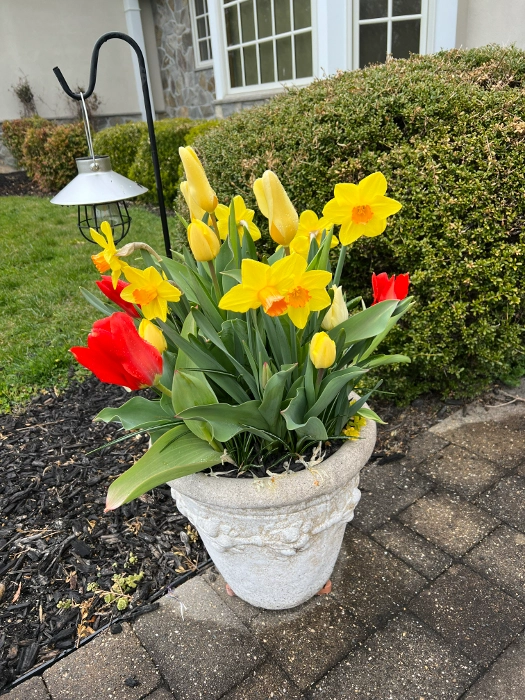Bulb Flowers List: When Do Flower Bulbs Bloom?

Do you find it overwhelming to plan a flower garden so you have continuous blooms?
I know I do, and I don't want to plant annuals every year. I want something I can plant once and have blooms all Spring, Summer and Fall for years to come.
Well look no further, I have researched all the common bulbs for the Planting Zones of 6-8 and put together a great reference for you.
Use my charts to create a masterpiece of blooms for years to enjoy.
Frequently asked questions:
When is the best time to plant bulbs?
Generally, if the flower blooms in the Spring, then plant the bulb in the Fall. If the flower blooms in the Fall, then plant it in the Spring.
For example, it's late April now in Maryland, so I am going to plant my Dahlias now along with my Elephant Ear bulbs. In the Fall (October-November), I will plant my tulip and Daffodils.
How many flowers do I get from one bulb?
The number of flowers produced from a single bulb can vary widely depending on the type of flower. Here's an overview of what to expect from some common bulbous flowers:
1. Tulips: Typically, each tulip bulb produces one flower. However, some species and varieties can produce multiple flowers from a single bulb.
2. Daffodils: Generally, each daffodil bulb produces one to three flowers, depending on the variety and bulb size.
3. Hyacinths: Each hyacinth bulb typically produces one dense flower spike, although sometimes a bulb can produce a secondary, smaller spike.
4. Crocuses: Each crocus bulb (corm) can produce several flowers, usually ranging from one to four.
5. Lilies: Each lily bulb can produce multiple flowers. The exact number can vary, but it's common for a mature bulb to produce anywhere from two to twelve flowers on a single stem.
6. Alliums: Each allium bulb usually produces one flower head, which can contain dozens of tiny flowers forming a spherical or rounded cluster.
The exact number of flowers can be influenced by factors such as the size and health of the bulb, soil conditions, and proper care and maintenance. Regular fertilizing, appropriate planting depth, and adequate watering can help maximize the flowering potential of each bulb.
Why aren't my bulbs blooming?
1. Incorrect Planting Depth: Bulbs need to be planted at the correct depth to ensure they bloom. Planting too deep or too shallow can prevent flowering. Generally, bulbs should be planted at a depth of about three times their height.
2. Poor Soil Conditions: Bulbs need well-draining soil. Heavy, clay-like soil can cause bulbs to rot, while overly sandy soil might not retain enough moisture. Improving soil with organic matter can help with drainage and moisture retention.
3. Lack of Sunlight: Most bulbs need full sun (at least six hours of direct sunlight per day) to produce flowers. If they're planted in too much shade, they might not bloom.
4. Overcrowding: When bulbs multiply over the years, they can become overcrowded, leading to competition for nutrients and space, which can inhibit blooming. Dividing bulbs every few years can alleviate this issue.
5. Premature Foliage Removal: After blooming, bulbs need their leaves to remain intact to photosynthesize and store energy for the next year's blooms. Cutting back the foliage too soon can prevent bulbs from storing enough energy to flower again.
6. Environmental Stress: Extreme weather conditions, poor soil conditions and nutrients can affect the blooming of your bulbs.
Do Bulbs Bloom the First Year?
Not all bulbs bloom in their first year after planting. Whether a bulb will bloom in its first year depends on several factors, including the type of bulb, planting conditions, and the quality of the bulb.
Here’s a breakdown of some key considerations:
1. Type of Bulb:
- Spring-flowering bulbs like tulips, daffodils, and crocuses are typically planted in the fall and often bloom in their first spring.
- Summer-flowering bulbs such as lilies, gladiolus, and dahlias are usually planted in the spring and bloom in the summer of the same year.
2. Quality of the Bulbs:
- High-quality, healthy bulbs are more likely to bloom in their first year. These bulbs should be firm, free from mold, and of an appropriate size for their species.
3. Planting Depth and Timing:
- Planting bulbs at the correct depth and time is crucial. For example, spring-flowering bulbs should be planted in the fall before the ground freezes, while summer-flowering bulbs are planted in the spring after the danger of frost has passed.
4. Growing Conditions:
- Adequate sunlight, well-draining soil, and proper watering are essential for bulbs to establish themselves and bloom. Poor conditions can delay or prevent blooming.
5. Pre-chilling Requirements:
- Some bulbs, like tulips and hyacinths, may require a period of cold treatment (pre-chilling) if they are planted in regions where winters are not cold enough. Without this, they might not bloom.
In summary, many common bulbs will bloom in their first year if they are planted correctly and given the right conditions. However, some bulbs may require more specific care or may take longer to establish before they produce flowers.
Related Articles:
The Best Hand Pruners for Arthritic Hands: A Review
Review of the 5 Best Garden Stools for Seniors
19 Shallow Rooted Plants for Your Raised Beds
Create A Wildflower Meadow: Our Simple Guide
Best Bulb Planting Tools for Seniors
Plant these 12 Perennial WildFlower Seeds in the Fall
What Season to Trim, Prune or Deadhead Hydrangeas
Happy Gardening!
Sue


